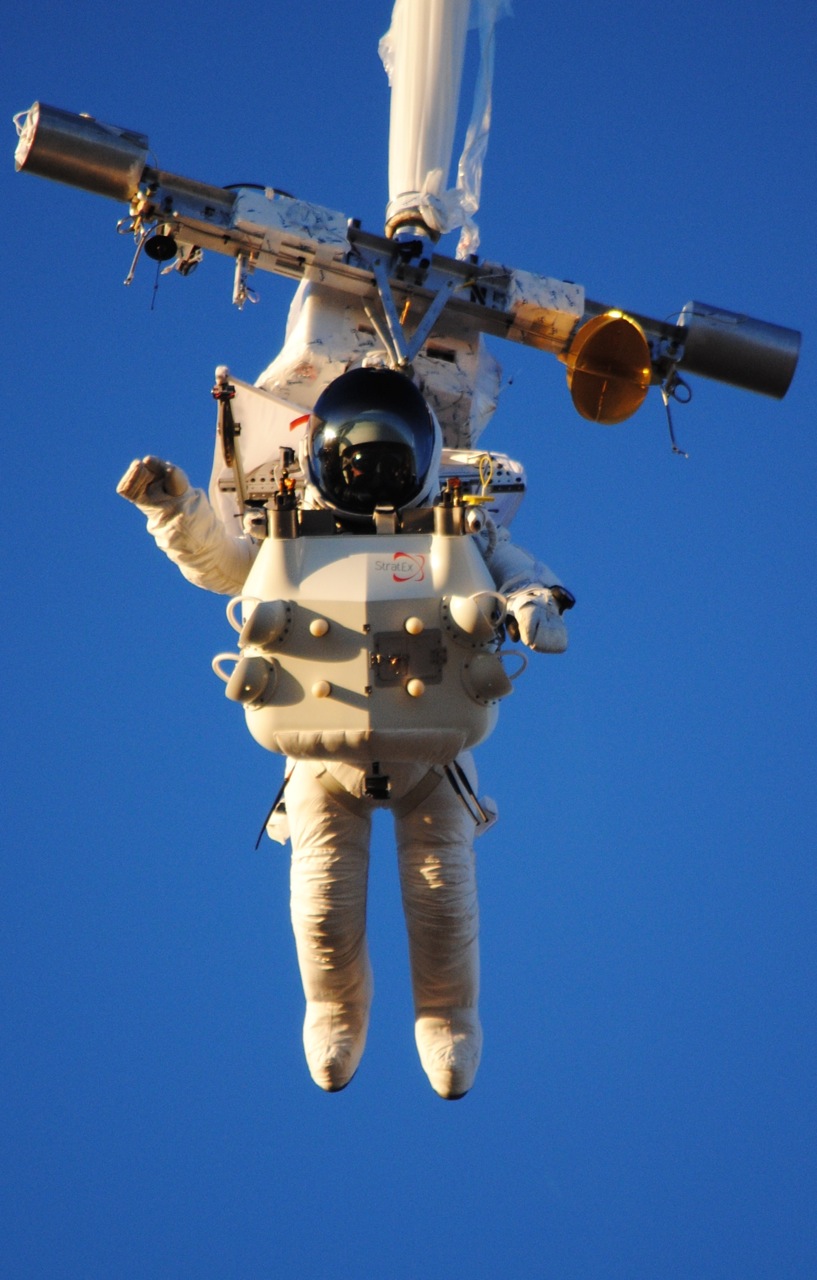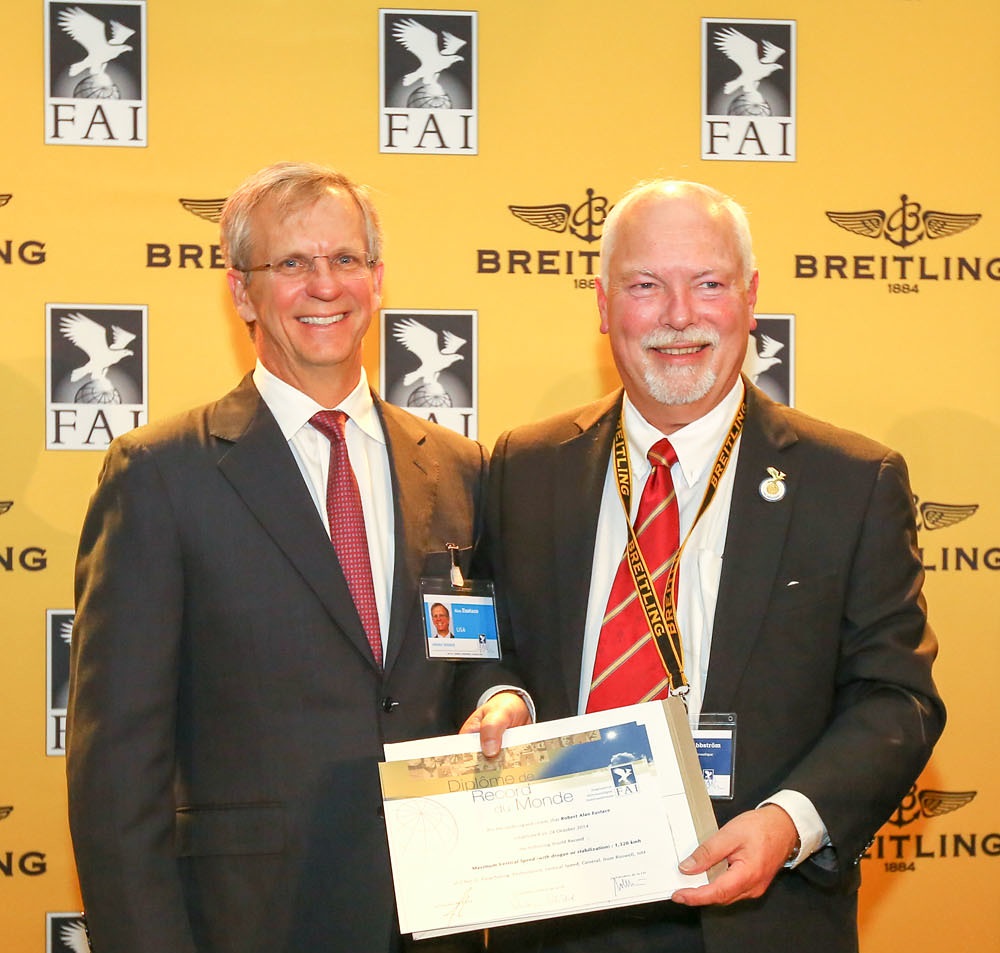Yet to be beaten: Alan Eustace’s high altitude parachute jump records still stand, 10 years on
Remarkable in its simplicity, Alan Eustace’s high altitude parachute jump on 24 October 2014 saw the 57-year-old float up, suspended below a gigantic helium balloon, to the outer edge of the stratosphere. He made three FAI parachuting records which still stand today, on the tenth anniversary.
Prior to a celebratory event in the USA's Kennedy Space Centre to mark the anniversary, Eustace shared his reflections on his famous parachute jump in an interview with FAI.
Rising through the stratosphere
Wearing a specially designed suit to protect him from the temperature and air pressure changes in the stratosphere, American skydiver Alan Eustace departed from Roswell, New Mexico, and rose slowly up and up into the sky, suspended beneath a 120 metre tall helium balloon.
In a two hour and seven minute long journey which he describes as "peaceful", he remarks that, "You can see the darkness of space, the curvature of the Earth, the fragile planet below..."
Rotating gently with the balloon, Eustace was treated to a 360 degree panorama which included the Rocky Mountains way, way below. The balloon eventually stabilised. Eustace and his Mission Control team agreed to begin the countdown.
Three FAI records
The first of Eustace’s FAI world records was made as soon as Mission Control pushed the button that released the father-of-two from the balloon: First record: Exit Altitude 41,422m.
After that serene ascent, suddenly the earth was rushing towards him. Eustace was accelerating rapidly. He broke the speed of sound after just 35 seconds. After 51 seconds he reached his peak speed, an eye-watering 1,320km per hour. Second record: Maximum Vertical Speed with drogue.
The drogue was absolutely essential to Eustace’s success. As Joseph Kittinger and his team found out during the Excelsior project’s high altitude parachute jumps, a drogue parachute for stability could – and still does – save the lives of countless skydivers, preventing them from entering a high speed spin.
Eustace sailed down to earth in freefall for 37,623 metres, before activating his parachute system. Four minutes and 27 seconds after being released from the balloon, he landed safely, just over 100km from where he launched. Third record: Distance of Fall with a Drogue.
Interestingly, Eustace also became the person to travel to the highest altitude in a balloon, his peak altitude being 41,574m. But this did not qualify as one of his FAI records, as he did not descend with the balloon.
The Descent
How did it feel, to be travelling so incredibly fast? "I had zero sensation of speed... It felt like I was falling in a void. I had no sense of gravity." As his eyes flicked between the earth and his altimeter, and he concentrated on staying in a stable position, he did not even notice the sonic boom he created. All he could hear was himself breathing. And then, "The moment you hear sound, it means you're slowing down." His canopy opened. "That's the moment I knew it was over." By this point, he was no longer alone. A helicopter joined him in the air, and a good friend skydived down alongside him.
Upon landing, Eustace felt, "Kind of detached. Like it was over. And kind of tired. And hungry!" He explains that he had been up very early in the morning to breathe oxygen prior to the start time, and was not allowed anything to eat.
Looking back on his achievement, ten years on, how does he feel about having built up the courage to have made his remarkable jump? He laughs, "I'm the opposite of a daredevil! I don't see it as courageous at all. People ask me what I was most worried about during the record jump, and I tell them that I wasn't worried at all. I was completely relaxed. I was completely confident in the team, the equipment, the preparation, the decision making, the weather, and the recovery team. We had run over 200 tests, and countless dry runs. If anyone on the team had doubts, anyone could have stopped the jump, but nobody did. That's how confident we were. Assembling a team of that quality is very difficult, and I was very, very fortunate, and now I'm extremely grateful. They gave up three years of their life and countless sleepless nights to make sure I was safe. You can't put a price on that!"
The meticulous preparations for the big day had taken four years.
The preparations
Eustace was one of countless children for whom space was a mythical destination, brought almost within touching distance by the Apollo programme.
And as a skydiver, engineer, and senior vice president of knowledge at a well-known internet search engine, the stratosphere held a deep fascination. Could it be explored by an ordinary human?
The idea began marinating as Eustace made contact with people who had the expertise to help him achieve his dream. Getting the right partners on board was essential. The basic idea was simple enough: a parachute system with drogue, a balloon, and a suit. But the details were a lot more complicated. He needed to withstand a dramatic temperature drop as he rose through the stratosphere, and the pressure decrease as he floated up towards space.

At the time, Eustace’s suit was the only life support system made by NASA suppliers for a commercial venture. Extensive testing took place in wind tunnels and outdoor jumps, to assure the team that Eustace would a) manage to manoeuvre himself to steer the parachute and b) stay alive.
But as he points out, "Even if I'd have been unconscious, the system would have got me down safely." Specialist companies created the rigging and balloon release mechanisms, the harness and container system and the main and reserve canopies which could open automatically. The innovative drogue deployment device ensured Eustace would not become entangled during the freefall.
The balloon’s payload – Eustace, his pressure suit, life support system and parachute system – weighed just under 200kg.
Before take-off, Eustace breathed oxygen to prevent decompression. He was loaded onto a truck and driven to the balloon which was filling with helium. “My heart rate was low,” he remembers, “I had a complete belief in the system.”
In fact, the 24 October jump was scheduled as the third and final jump. On 4 October, Eustace rose to 17.3km and on 15 October, he floated higher than Kittinger in 1960, to 32.2km, but decided not to publicise the achievement, in preparation for the third jump. Finally, Eustace and his team were ready for the big day.
records waiting to be beaten
This third jump surpassed the high-altitude parachute jump made by Felix Baumgartner in 2012, by 2,452m. The Red Bull Stratos project had involved a capsule, a significantly larger balloon and a substantial budget. In comparison, Eustace’s self-financed project with his team of experts kept simplicity as a core value, alerting the media only after the jump had been successful.
Enthused after the success of his remarkable skydive, Eustace initially had big plans to break more records in the suit, which could be used for high altitude ballooning, hang glider or sailplane/glider flights, but ultimately he donated it to the Smithsonian US National Air and Space Museum’s Steven F. Udvar-Hazy Center in Chantilly, Virginia, USA, where it is kept in a controlled atmosphere. Joseph Kittinger became a personal friend and recently, Eustace took Kittinger's children to visit the suit. "I spent so much time in that suit and now I have to wear special gloves to touch it!" he jokes.
Is he surprised the record still stands, ten years later? "Absolutely. The record is there to be broken. I think someone will beat it relatively soon."

Alan Eustace (left) and John Grubbström at the FAI Awards Ceremony 2015. Credit: Fayez Mansour
Images courtesy of FAI archives/Alan Eustace

